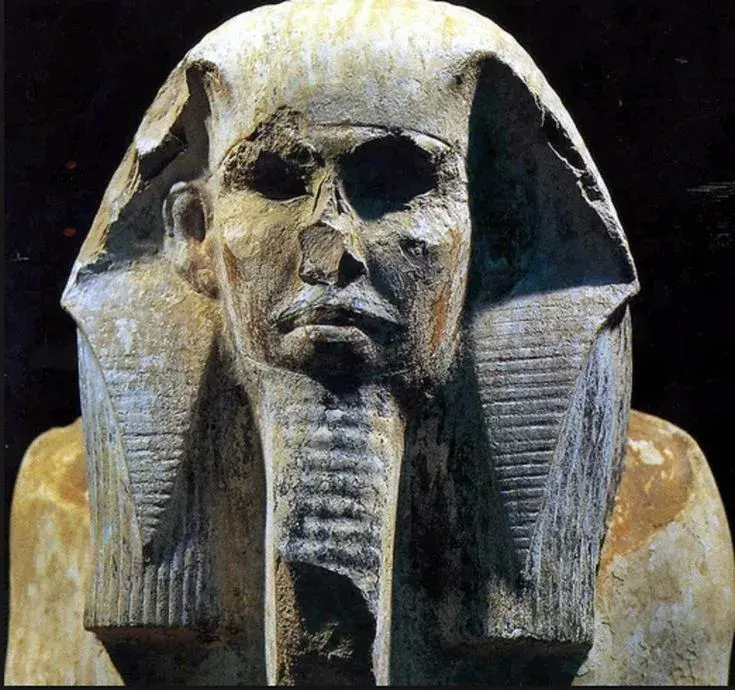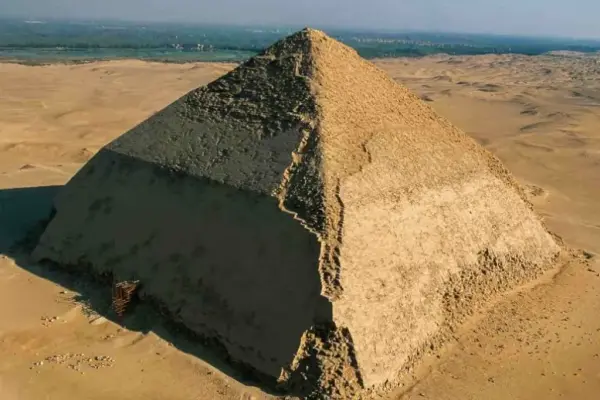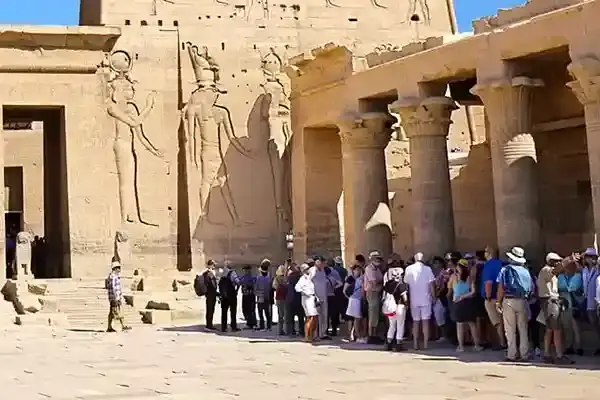Does Dahshur Pyramids have bodies? Historians have been baffled by this fascinating issue for ages.. While these ancient structures are famous for their unique shape and historical significance, recent discoveries might reveal more than we expect. In fact, a study from the Egyptian Ministry of Antiquities found that many tombs within these pyramids still hold secrets waiting to be discovered according to egyptindependent.com. Let's dive into 5 fascinating facts about the Dahshur Pyramids and what they might reveal about Egypt's ancient past.
Table of contents [Show]
- What are the facts about the Dahshur pyramid?
- Does dahshur pyramids have bodies?
- Do Egyptian Pyramids Have Mummies?
- The Purpose of the Pyramids
- Visiting Dahshur: Can I Explore the Red Pyramid?
- Dahshur history
- The Red Pyramid of Dahshur: A Must-See Ancient Wonder
- The Dahshur Pyramid Inside: A Unique Exploration
- Who Constructed the Red Pyramid? A Pharaoh’s Vision
- What Are the Structures of the Red Pyramid?
- Why Is It Called the Red Pyramid?
- Red Pyramid Facts: Unveiling Ancient Wonders
- The exterior and interior appearance and rooms of the Red Pyramid
- Summary
- FAQs
What are the facts about the Dahshur pyramid?
Looking for a less crowded and more distinctive pyramid experience? Then Dahshur is the place for you! Have you ever heard of the Dahshur pyramids? They're in Egypt, situated around 40 kilometers south of Cairo. And guess what? They hold fascinating secrets!
Maybe like: Strange Facts About The Pyramids
The Pyramids of Dahshur: Bent and Red Wonders
Firstly, there are TWO main pyramids here. They're known as the Bent Pyramid and the Red Pyramid.
The Bent Pyramid is unique. It changes the angle halfway up! Archaeologists believe they changed the design during construction. It stands at about 101 meters tall.
Moreover, the Red Pyramid is significant. It's considered the first successful attempt at building a true pyramid. It's also the third-largest pyramid in Egypt. It measures roughly 105 meters tall and was built using limestone blocks. It showcases early pyramid construction techniques.
A Legacy of Pharaoh Sneferu
Interestingly, these pyramids were built by Sneferu, a fourth-dynasty pharaoh and the father of Khufu, who built the Great Pyramid of Giza.
Sneferu was a powerful ruler of the Old Kingdom, and the Red Pyramid is believed to be his actual grave
This remarkable feat of engineering stands as a testament to ancient Egyptian imagination.
Why Visit Dahshur?

Dahshur was a royal necropolis, meaning it was a burial ground for pharaohs and their families. Although the pyramids were looted in ancient times, archaeologists still find amazing artifacts from this site.
Today, Dahshur is a popular tourist site. You can explore conglomerations and learn about their history. Are you planning your visit? Check out this 8-day Pyramids and Nile tour for an unforgettable experience.
So, does Dahshur pyramids still have more secrets to reveal? Absolutely! Ongoing research continues to discover new and fascinating details about these ancient wonders. It's a must-visit for any history buff! So, next time you're in Egypt, be sure to add Dahshur to your itinerary. You won't be disappointed!
Does dahshur pyramids have bodies?
The Dahshur pyramids are shrouded in mystery. But one question lingers: do these pyramids still hold the bodies of ancient pharaohs? Let's explore this intriguing topic:
A Royal Necropolis
Firstly, it's important to remember that Dahshur was a royal necropolis. This means it was a burial ground for pharaohs and their families.
The Impact of Looting
However, the pyramids were heavily pillaged in ancient times, which means many of the original burials were disturbed.
Archaeological Discoveries
Despite this, archaeologists have still made some fascinating discoveries. For example, they found the remains of King Hor and Queen Nubkheperetra in the Bent Pyramid.
The Red Pyramid’s Mystery
Interestingly, the Red Pyramid is believed to be the final resting place of Pharaoh Sneferu. However, his body has not been set up.
Smaller Pyramids at Dahshur
Moreover, there are several smaller pyramids at Dahshur. Some of these may still contain undisturbed burials.
Ongoing Research
Furthermore, ongoing research continues to shed light on Dahshur's secrets. New technologies allow archaeologists to explore the pyramids without causing damage.
So, does Dahshur pyramids have bodies waiting to be discovered? It's certainly possible! While many of the original burials were looted, there's always a chance that some remain hidden within these ancient structures. Historians and archaeologists are still fascinated by the mystery.
While the Dahshur pyramids may not hold all their original secrets, they continue to inspire us with their ancient mysteries. If you're planning to explore Egypt’s wonders, consider this 8-day Cairo, Luxor, and Aswan classic tour to dive deeper into the country's rich history. Who knows what treasures still lie hidden within their depths?
Do Egyptian Pyramids Have Mummies?

The Purpose of the Pyramids
Did you know that the Egyptian pyramids weren’t just piles of stones? They were elaborate tombs built to save pharaohs and their treasures for the afterlife!
Looted Tombs and Missing Mummies
The question of whether Egyptian pyramids hold mummies is fascinating. These ancient structures were designed to safeguard the pharaoh’s body and belongings. Sadly, many pyramids were looted centuries ago, leaving them empty and robbed of mummies and treasures.
Discoveries in the Pyramids
Despite this, some mummies have been discovered. King Tutankhamun’s tomb, for example, was found nearly intact. Interestingly, not all pyramids were built the same way. Some had complex layouts and hidden chambers, making it harder to find mummies.
The Mystery of the Dahshur Pyramids
In places like Dahshur, the pyramids may still hold secrets. The dry Egyptian climate helped save numerous remains thousands of times. Modern technology aids in the search for mummies. Non-invasive techniques help archaeologists explore without causing damage.
Could the Dahshur Pyramids Have Bodies?
So, do Dahshur pyramids have bodies? It’s possible. While many tombs have been disturbed, ongoing research might still discover hidden treasures and mummies.
The Fascinating Mystery Continues
The pyramids continue to captivate us with their mysteries and history.
Visiting Dahshur: Can I Explore the Red Pyramid?

Absolutely! The Red Pyramid is open to visitors. It's one of the main attractions at Dahshur. Known for its reddish limestone, it's Egypt's first true pyramid.
You can go inside and explore its chambers. It's an amazing unforgettable experience.
Firstly, remember to buy a ticket. Secondly, wear comfortable shoes. You'll be doing a lot of walking. Also, it can get hot inside the pyramid. So, bring water.
This pyramid is less crowded than Giza, making it perfect for a peaceful exploration. You can enter its inner chambers and see the genius of ancient Egyptian builders.
The Red Pyramid is one of the true wonders of ancient Egypt. It is the oldest true pyramid in the world. Plus, it's the third-largest in Egypt. Don't miss the chance to see it up close! If you're planning to explore more of Egypt's treasures, check out this 10-day Cairo, Aswan, Luxor, and Hurghada overland tour for an unforgettable journey through history.
Read: What are the important holidays in Egypt?
Dahshur history

Dahshur: An Exploration of Time
An amazing ancient site that demonstrates Egypt's architectural development is Dahshur. Some of the most unusual pyramids in history can be found there.
For its pyramids, it is well-known. But beyond those magnificent buildings, it has a rich past.
A Royal Necropolis of the Old Kingdom
First of all, during the Old Kingdom, it served as a royal necropolis. Pharaohs and their families were therefore interred there. Some of the most well-known pyramids of Dahshur were constructed by the strong pharaoh Sneferu, including the Bent Pyramid and the Red Pyramid.
The Bent and Red Pyramids
The Bent Pyramid is unique, showcasing an early attempt at smooth-sided construction, with a change in angle halfway up. This shows how the Egyptians experimented with pyramid design.
The Red Pyramid was the first successful pyramid with smooth sides, and set the standard for later structures such as those at Giza.
Decline and Revival
Secondly, Dahshur fell into disuse after the Old Kingdom. However, it was revived in the Middle Kingdom. Amenemhat II built a pyramid there. And, Senusret III built a complex of temples and tombs.
Dahshur Today
Dahshur was abandoned again after the Middle Kingdom and remained forgotten for centuries. Today, it is a UNESCO World Heritage Site, attracting visitors eager to explore its rich history and stunning pyramids.
Does Dahshur Pyramids Have Bodies?
The mystery endures, as many tombs were looted. Yet, its secrets continue to intrigue archaeologists and visitors alike. For a deeper dive into Egypt's captivating history, consider this 12-day Pyramids, Nile, and Sinai tour to explore even more of its ancient wonders.
Read about: Is The Sphinx Older Than The Pyramids
The Red Pyramid of Dahshur: A Must-See Ancient Wonder

A Symbol of Ancient History and Innovation
The Red Pyramid in Dahshur is an incredible testament to ancient Egyptian engineering. Built by Pharaoh Sneferu, it stands as a remarkable symbol of innovation and architectural mastery.
Massive Size and Unique Appearance
This pyramid is truly massive—it's the third-largest in Egypt! Its distinctive reddish hue comes from the limestone used in its construction, giving it both its unique look and iconic name.
The First "True" Pyramid
The Red Pyramid is known as the first successful smooth-sided pyramid in history. This achievement set the foundation for future pyramids, including the world-famous pyramids of Giza.
Towering Height and Historical Significance
Standing 104 meters tall, the Red Pyramid showcases the incredible architectural skills of ancient Egypt. It played a key role in shaping the evolution of pyramid construction.
Explore the Pyramid's Interior
Want to venture inside? You can! The Red Pyramid is open to visitors. A descending passage leads to three impressive chambers, giving you a fascinating glimpse into the craftsmanship of the ancient world.
A Tranquil Alternative to Giza
Unlike the bustling pyramids of Giza, the Red Pyramid offers a peaceful and less crowded experience. It's the perfect spot for history lovers seeking a serene adventure.
Don't Miss Out!
Visiting the Red Pyramid is an unforgettable experience. Add it to your Egypt travel bucket list and immerse yourself in the wonders of ancient history! For an even richer experience, check out the Grand Egyptian Museum Trial Phase Tour to complement your journey through Egypt's treasures.
Take a look at: Egypt trips to the pyramids
The Dahshur Pyramid Inside: A Unique Exploration

Ever wondered what secrets lie hidden within the Dahshur pyramids? Prepare to be amazed!
Narrow Passages
Tight corridors lead deep into the pyramid’s core, revealing its ancient secrets.
Impressive Chambers
The Red Pyramid has three chambers stacked vertically, connected by passages. In the Bent Pyramid, there are two chambers. One is above the other.
Architectural Brilliance
the pyramids have high ceilings. And some have interesting architectural features. For example, you might see corbelled arches. Corbelled ceilings and precise designs showcase the skill and genius of ancient builders
Cool Atmosphere
The interior feels quiet and serene, adding a touch of mystery.
Air Shafts
Ingenious ventilation systems ensure the structure’s longevity.
Does Dahshur Pyramids Have Bodies?
Although many tombs were looted, some mysteries remain unsolved. This mystery adds to its timeless allure, drawing curious minds.
A Glimpse of History
Walking through feels like stepping into Egypt’s glorious past.
Less Crowded
Explore at your own pace without the crowds found at the Giza pyramids.
Does Dahshur pyramids have bodies? This question continues to fascinate, drawing history lovers from around the world.
Read about: Can You Go Inside The Great Pyramids
Who Constructed the Red Pyramid? A Pharaoh’s Vision

One of the wonders of ancient Egypt is the Red Pyramid. But who built this magnificent structure?
The Red Pyramid in Dahshur was built by Pharaoh Sneferu, an innovative and powerful ruler of Egypt’s Fourth Dynasty. Sneferu was determined to build a pyramid that reached the heavens, a symbol of his power and his connection to the gods. And he had big ambitions. He wanted to build the perfect pyramid.
A Turning Point in Egyptian Architecture
Constructed around 2600 BCE, it was the first successful smooth-sided pyramid and a turning point in ancient Egyptian architecture. The Red Pyramid, with its smooth sides and perfect proportions, stands as evidence of his drive and vision.
Sneferu’s Early Struggles and Achievements
Sneferu’s earlier attempt, the Bent Pyramid, had design excrescencies. However, he learned from this and created the Red Pyramid, his crowning achievement. The pyramid’s reddish hue comes from its limestone blocks, which give it a unique charm.
The Mystery of the Dahshur Pyramids
Does Dahshur pyramids have bodies? Many tombs were looted, and this question remains a mystery, adding to its allure.
A Symbol of Pharaoh Sneferu’s Ambition
Today, the Red Pyramid symbolizes Sneferu’s ambition and the inconceivable skill of ancient builders Visitors marvel at its serene atmosphere and historical importance, making it a must-see for history enthusiasts.
An Unforgettable Experience
Today, you can visit the Red Pyramid and explore its inner chambers, where you can almost feel the presence of Pharaoh Sneferu himself. It's an unforgettable experience that will transport you back in time to the era of ancient Egypt's greatest builders. For an even more immersive journey, consider adding the 10 Days Round Trip Nile Cruise and Pyramids Tour to your travel plans.
Read about: Pyramids land private tours
Why Was the Red Pyramid Built? A Pharaoh's Vision for Eternity

Imagine a pyramid so grand that it would guarantee your place in the afterlife. That was Pharaoh Sneferu's vision for the Red Pyramid.
The Red Pyramid in Dahshur is a magnificent sight. Have you ever wondered, though, why it was constructed? Well, it was all about Pharaoh Sneferu! He was an ambitious king who ruled Egypt during the Old Kingdom.
He dreamed of building the perfect pyramid, a monument to his power and a gateway to the afterlife, a lasting symbol of his connection to the gods, his ambition, and the skill of the ancient Egyptian builders.
Today, the Red Pyramid still stands tall, a testament to Sneferu's vision. It's a reminder of the incredible achievements of the past and a must-see for anyone visiting Egypt.
Read about: Did Thoth Built The Pyramids
What Are the Structures of the Red Pyramid?

Ever Wondered What Makes the Red Pyramid So Special?
Let's examine its distinctive structure in more detail!
Smooth Sides: A Breakthrough Design
The Red Pyramid features smooth sides, unlike earlier step pyramids. This innovation marked a significant advancement in pyramid design.
A Long Descending Passage
A long, narrow passage leads to the pyramid's inner chambers, adding an element of mystery to the structure.
Three Large Chambers Inside
Inside, you'll find three chambers. The first two are connected, while the third, believed to hold a burial site, is deeper and smaller. All chambers feature high, corbelled ceilings.
Made of Red Limestone
The pyramid’s reddish color comes from the red limestone used in its construction. Its large base adds to its grandeur.
Shiny Outer Layer
Originally, the pyramid was covered in shiny white limestone, giving it a magnificent, polished appearance.
Does Dahshur Pyramids Have Bodies?
No remains were found, but looted tombs leave room for mysteries. This enigma draws historians and tourists alike.
Visit the Red Pyramid
Open to visitors, the Red Pyramid is a must-see for anyone interested in ancient Egypt. To make the most of your trip, consider adding the 7-Day Explore Classical Egypt Cairo & Sharm El Sheikh Tour to your itinerary for a deeper exploration of Egypt’s rich history and culture.
Why Is It Called the Red Pyramid?
The Red Pyramid has a unique name. However, what gives it that name?
Firstly, it's all about the color! Red limestone is used to build the pyramid.This gives it a reddish hue. It's especially noticeable at sunset.
It has a distinctive and eye-catching look because of these stones.
Secondly, the color changes throughout the day. In the morning, it looks almost pink. In the evening, it appears deep red. It's quite a sight!
thirdly, the name helps distinguish it. There are other pyramids at Dahshur. The Bent Pyramid is one example. So, the name "Red Pyramid" helps avoid confusion.
Red Pyramid Facts: Unveiling Ancient Wonders

Want to explore a pyramid that's less crowded than those at Giza? Then the Red Pyramid at Dahshur is calling your name!
The Red Pyramid in Dahshur is truly amazing! Firstly, it's HUGE. It's the third-largest pyramid in Egypt. Secondly, it's ancient. Pharaoh Sneferu was built around 2580 BC. That's over 4,500 years ago!
This architectural marvel stands about 105 meters tall, making it one of Egypt’s largest pyramids.
It was also a breakthrough in design. It was the first successful "true" pyramid, meaning it has smooth sides, unlike earlier step pyramids. This makes it a super important historical site.
The Red Pyramid is open to visitors. You can even go inside and explore its rooms and see more options! It's an unforgettable experience. So, add it to your Egypt bucket list. You won't be disappointed! And while you're planning your trip, don't forget to check out our blog on When Was the Great Sphinx Built for more fascinating insights into Egypt's ancient wonders.
Read about: What countries have pyramids- Know the full details
The exterior and interior appearance and rooms of the Red Pyramid
The Red Pyramid is an amazing sight. Firstly, let's talk about the outside. It has a smooth-sided structure that stands tall, a testament to ancient engineering. And it's made of red limestone. This gives it a unique color and vibrant look.
Secondly, let's look inside. The pyramid has three chambers. They are connected by passages. The chambers have high ceilings. And they are quite impressive.
The high, corbelled ceilings showcase advanced architectural techniques. These chambers were meant for Pharaoh Sneferu's burial.
Does Dahshur pyramids have bodies? No remains were found, adding to its mystery. Visitors today marvel at its history and architectural beauty. If you're planning your visit, you might also want to learn how far Cairo is from Hurghada to make the most of your Egyptian adventure.
Maybe like: Pyramids were most popular during which of the following periods
Summary
So, Dose Dahshur pyramids have bodies? It's a question that continues to fascinate me. While many tombs were looted, some secrets may remain hidden within these ancient wonders. Want to learn more about the Dahshur pyramids and their fascinating history? Explore our Egypt tour packages today! We offer a wealth of information and resources to help you plan your trip and discover the mysteries of ancient Egypt. Let us be your guide!
FAQs
What Does "Does Dahshur Pyramids Have Bodies?" Mean?
This question explores whether the Dahshur Pyramids, located near Cairo, contain mummies or other remains. These pyramids were built as royal tombs, but many were looted over the centuries. Despite this, some tombs might still hold hidden treasures or even bodies, keeping historians intrigued.
What Makes the Dahshur Pyramids Unique?
The Bent Pyramid has a distinctive shape, with a sudden angle change midway, while the Red Pyramid is the first true pyramid. These unique features attract researchers and tourists alike.
What are the chances that new discoveries will show that Dahshur pyramids have bodies?
There is always potential for new findings as technology advances. Each archaeological dig brings hope for discovering untouched chambers with bodies.
How do archaeologists determine if the Dahshur pyramids have bodies? Archaeologists use non-invasive techniques like ground-penetrating radar and advanced imaging to scan the interiors, looking for signs of burial chambers and bodies
Do Not forget to take a look at our Egypt Classic Tours and see the offers.
Popular Categories
Popular Posts

Top Alexandria Beaches You Must Visit 2026

What are the important holidays in Egypt?









